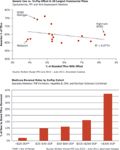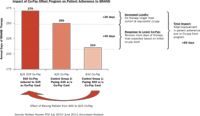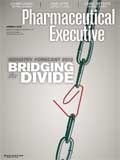Copay Cards and Coupons: Letting the Facts Get in the Way
Mason Tenaglia offers empirical defense of coupons and copay offset programs.
In recent months, Pharmacy Benefit Managers (PBMs) have emerged as vocal critics of the drug industry's reliance on copay cards, coupons, and other tools to help patients offset the cost of innovative brand-name medicines. The PBMs' leading trade group—the Pharmaceutical Care Management Association—has taken the position that the practice represents an additional driver of costs to the healthcare system. Hence the opportunity arises for a potentially useful debate focused around the following question: Do copay cards simply deflect costs from industry and patients back to the payer, or do they instead provide a richer social benefit by delivering access to proven therapies, raising patient adherence rates and generating a superior public health outcome? Mason Tenaglia, managing director of the Amundsen Group and a member of Pharm Exec's Editorial Advisory Board, weighs in this month with a critique of the evidence behind the Pharmaceutical Care Management Association (PCMA) position—and a spirited defense of current industry practice:

(Getty Images / photosindia)
PCMA's position is neatly summarized in a new white paper, "How Copay Coupons Could Raise Prescription Drug Costs by Over $32 Billion Over the Next Decade," which has led to heavy and largely favorable coverage in the media. Unfortunately, it was picked up by the mainstream media and led to a series of newspaper, magazine, radio, and television reports that indict the pharmaceutical industry at large. Unfortunately, no one bothered to ask questions or check the facts on any of the assertions made by the white paper's authors. The arguments against, which attack the use of copay offset programs—such as the claim that copay offset cards lead to less generic utilization and cost the employers and states more for prescription coverage—are not backed up by a single analysis of actual data in any therapeutic class. Amundsen Group believes that now is a good time to let the facts get in the way of this indictment of the industry.
Over the last several years, we have studied the value of coupon and copay card offset programs to manufacturers and patients across a wide range of therapeutic classes. We have analyzed both redemption data sent to our clients by the copay card offset program vendors (McKesson, Cegedim, PSKW, Triple i, etc.) and in Anonymous Patient Longitudinal Data (APLD) licensed to our clients by Wolters Kluwer in more than 30 retail and specialty therapeutic markets. In the raw APLD data, we can identify secondary payers (the copay card offset vendors) and through a "look-back," can determine whether a patient who used an offset was new to therapy, switched from a competing brand or generic, or was a continuing patient.
These two data sources and a longitudinal approach are critical to a fair and fact-based analysis of the cost and value of copay card utilization. PCMA charges that their members cannot see these "shadow transactions," but yet has drawn sweeping conclusions about the impact of copay programs nonetheless. Inferences from the design of a single new program—the $4 copay card offset program for Lipitor, and its impact after November 2011, can simply not be applied to all brands and therapeutic classes.
Our empirical analysis and experience would lead to a very different set of conclusions.
1. Copay card program usage is not correlated with lower generic utilization in any of the major therapeutic classes;
2. Coupons are most frequently used by patients taking the least expensive brands for employers and insurers;
3. Most of the money invested by U.S. branded pharmaceutical companies into copay card offset programs goes into specialty and biologic products or therapies that have no available generic alternatives and benefit PCMA's members as much as the pharmaceutical companies; and
4. The return on investment for most brands comes from higher adherence to therapies that have already been chosen by the physician and patient.
For the vast majority of the $4 billion that we estimate the industry will spend in 2011, coupons and copay card offset programs are the only way of ensuring that a brand's patients can always get affordable access to medications and the most cost-effective way of ensuring patient adherence to prescription therapy. It seems unfathomable that PCMA could argue that affordability and extended medication adherence are bad things for patients, employers, insurers or healthcare providers.
Moreover, we believe that these programs should be made available to "standard eligible" patients in Medicare Part D who carry the greatest individual cost burden for prescription medications and who are the least compliant, least persistent patients in the U.S.
We will use actual claims data to ask and answer each of the following questions:
1. Do copay card programs lead to less generic usage? Certainly, there are a few copay card offset programs that lead commercially insured patients to fill a branded (and more expensive) product when there is a perfectly good generic that is a near, but not exact, substitute.

However, for the highest-dollar-value therapeutic classes, the intensity of copay card use has no relationship to generic uptake. Our analysis of the top three classes by Per Member Per Year (PMPY) cost to PBMs and insurers shows that the rate of generic uptake or conversion is not correlated to the percentage of prescriptions that use a copay offset in the 15 largest commercial payers.
2. Do copay card programs lead to the use of higher-cost brands? In these large therapeutic classes, there are actually far more copay card program transactions that are used by Tier 2 contracted prescriptions than by Tier 3 non-contracted prescriptions. Due to the deep discounts now required to obtain preferred Tier 2 status (see "Out of Control," Pharm Exec May 2011), the contracted brands are almost universally the lower-cost brand for employers and manufacturers. For example, in the DDP4 class, Januvia, which has paid for Tier 2 status in more commercial payers than its competitors, also pays for more transactions with copay card offsets than all of its competitors combined. In the first half of 2011, 63 percent of Januvia prescriptions that used an offset would have gotten a Tier 2 copay card without a program.
The competitive dynamics in almost any class led to this same result. The largest brands in the class have an advantage in negotiating for Tier 2 access, as they have the most drug spend "in play." The third or fourth brand to launch in the class ends up "non-preferred," and, in order to get high-quality access for its drug, initiates a copay card program. The larger brands, despite having contracted to get patients lower copayments, are afraid to lose their advantage and "double down" by instituting a copay card offset program. This doesn't make a lot of business sense for the manufacturers, but they may not even realize that it is possible to optimize contracting and copay card offset spending at a payer, or even geographic, level.
3. Where does the money go? Subsidizing Specialty Tiers? No one really knows how much all the U.S. pharmaceutical manufacturers spend on copay card programs in aggregate across all brands. By working across 30 therapeutic areas, comparing actual redemptions from our clients with what we see in APLD, and taking a SWAG at claims that we can't see in specialty pharmacy, we have estimated the 2011 spending on copay card offset programs to be about $4 billion. This represents about 2 percent of gross branded drug spend in the U.S., although the experience varies quite significantly by therapeutic markets.
The PCMA white paper infers that all this money is being spent keeping patients away from perfectly good therapeutic—though not chemically equivalent—generic alternatives. The truth is that the largest budgets for copay card offset programs are found in specialty brands where there are no substitutes. For TNF inhibitors, MS therapies, HIV products, Hepatitis B and C therapies, and oral oncolytics, individual brands may be spending $20 million to $140 million per year. Collectively, we estimate that specialty products represent just over 51 percent of total annual spending on copay card programs and coupons.

This is because the difference between Tier 2 and Tier 3 out-of-pocket costs for a retail product in diabetes, dyslipedimia, or asthma may be $25, while the average offset for the specialty products is closer to $125. Specialty tier cost-sharing can be particularly onerous due to the incidence of co-insurance and deductibles for both contracted and non-contracted brands.
Every commercial payer has some cohort of patients, oftentimes in their "at risk" books of business, which have excessive patient cost sharing for biologics. In the largest specialty classes (TNF inhibitors, MS, oncology), we observe that between 5 percent and 15 percent of new commercially insured patients may be exposed to co-insurance or copayments greater than $400 per month regardless of the branded product's contract status. Manufacturers who have done the analysis are often stunned to find out that they may be paying a hefty rebate to payers who have co-insurance or high deductible designs. In the absence of copay card offset programs, as many as one-third of these patients would be abandoning their initial prescriptions. Without the support of the manufacturers, patients with severely debilitating diseases could go undertreated or even untreated. Worse, they could be exposed to substantial risk for medical claims as a result. Employers and insurers could not want that outcome. Without the support provided by manufacturers, they would have many more untreated—or treated but unhappy—members. And we can imagine how many additional complaints their employer customers would be fielding!
In Medicare Part D, Amundsen has analyzed more than a dozen specialty products where the Standard Eligible population will face a "specialty tier" copay of more than $300 per prescription. Over a third of those patients will "abandon" their prescription. Many will never be treated.
If CMS were to allow copay card offset programs, there is absolutely no basis for projecting an $18 billion dollar increase in cost. First, more than half the utilization of branded drugs in Part D is from the low-income subsidy cohort who have copays under $6.60 and wouldn't need a copay card offset. Second, the real cost of allowing copay card offsets could actually be zero. Combined medical and pharmacy costs in Medicare for oncology, rheumatology, and MS might actually be lower as a result of compliant patients who would remain adherent to their therapy.

4. What's Wrong with a Positive ROI? Copay card offset programs are one of the best places for a pharmaceutical company to invest. And the fact that the returns are as high as 4:1 (and up to 6:1) is an indication of how valuable the offers are to patients. PCMA would have you believe that the source of that high return is from saving prescriptions that would have otherwise been filled with a generic medication. In fact, it is far more likely to come from patients who would have gone untreated or come from improved adherence through lower monthly out-of-pocket expenses.
The expected return on investments in copay card offset programs will depend on how long each is designed to last, the richness of the benefit, how broadly it is distributed, competitive programs, and where in the product lifecycle a program is introduced. Many programs that we have evaluated actually have negative returns, as they simply offer too much subsidy to patients who would be happy to pay a Tier 2 (and rebated) copay.
The two instances where copay card offset and coupon programs that Amundsen has analyzed consistently produce positive returns are at the time of launch, or in classes where continuing patients are sensitive to the monthly out-of-pocket expense. At launch, when a new medication would likely have a Tier 3 copay before the manufacturers could get a contract in place, copay card offset programs make new therapies affordable. Later in the lifecycle, a well-designed program can often add 30 to 60 days of additional patient adherence to therapy in a year. In many disease areas, such as hypertension, diabetes, asthma, and stroke, studies have shown that improved compliance will lead to lower hospitalization rates and annual medical costs. As with specialty coverage, employers and insurers should be thanking the pharmaceutical marketers for the help in getting—and keeping—patients on their medications.
At the end of 2012, when there are multiple generic suppliers of atorvastatin and managed care plans have instituted MACs on the molecule and NDC-blocked the branded version, we will know whether Pfizer's high-profile attempt to hold branded share of Lipitor with a pay-down to $4 will actually cost employers and insurers more money. If that is the case, then those payers should bring it up in negotiations with Pfizer, and anyone who emulates the company, when it tries to get preferred, unrestricted status for its remaining branded products. Until then, let the case be clear that coupons and copay cards, in aggregate, are a good thing for patients, physicians, and employers, along with the manufacturers.
Mason Tenaglia is Managing Director of the Amundsen Group and a member of Pharm Exec's Editorial Advisory Board. He can be reached at mtenaglia@amundsengroup.com

The Misinformation Maze: Navigating Public Health in the Digital Age
March 11th 2025Jennifer Butler, chief commercial officer of Pleio, discusses misinformation's threat to public health, where patients are turning for trustworthy health information, the industry's pivot to peer-to-patient strategies to educate patients, and more.
Applying Porter’s Five Forces to Portfolio Management in Pharmaceutical R&D: A Strategic Roadmap
March 17th 2025The increasing costs and complexity of R&D in the pharmaceutical industry have necessitated the adoption of strategic portfolio management to optimize resource allocation and enhance competitive advantage.
Navigating Distrust: Pharma in the Age of Social Media
February 18th 2025Ian Baer, Founder and CEO of Sooth, discusses how the growing distrust in social media will impact industry marketing strategies and the relationships between pharmaceutical companies and the patients they aim to serve. He also explains dark social, how to combat misinformation, closing the trust gap, and more.